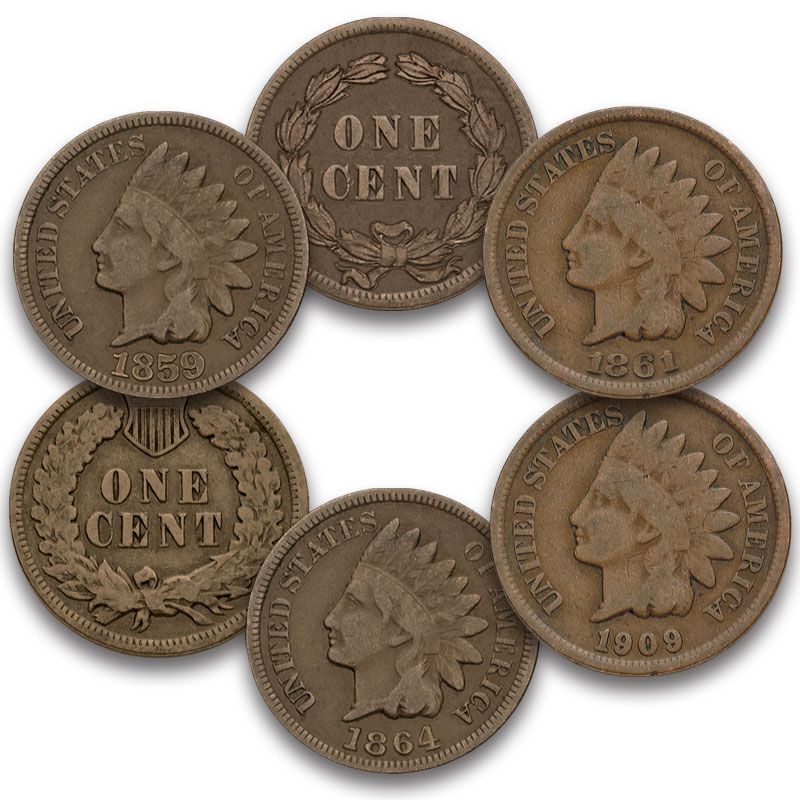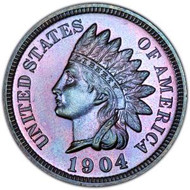Collecting Indian Head Pennies
Posted by Bullion Shark on Jan 10th 2022
Collecting Indian Head Pennies
In the mid-18th century large gold deposits were discovered in California, which led inflation to rise, and the price of copper was fluctuating, which led the U.S. Mint to explore alternatives to cents made of all copper. In 1857 it rolled out a new cent known as the Flying Eagle that was made of 12% nickel and 88% copper. That gave the coins a brighter and whitish appearance.

But those cents ran into production problems because the high points of both sides of the coin opposed each other, and it was difficult to get them to strike right in the copper-nickel alloy. This led Mint Director Snowden to ask James Longacre, a mint engraver who had designed the Flying Eagle cent, to create a new design for the cent.
After considering several different pattern coins with different designs, Snowden chose one with an obverse that resembled the $5 gold of the time and a reverse with an oak and laurel wreath around the denomination. This one had the merit of being the lowest relief of those considered, which meant it would strike well.
Indian Head penny design
Thus was born the Indian Head cent whose depiction of Liberty on the obverse as a Native American was said for a long time to be based on Longacre’s daughter, Sarah, who supposedly visited the artist at work one day as a child and tried on an Indian headdress. But this was not possible since Sarah was 30 at the time, and Longacre even stated it was actually based on a statue called Crouching Venus that the Vatican had lent.
The other unusual aspect of the design is that while it depicted what looked like an Indian, the facial features were actually Caucasian. Moreover, the type of headdress depicted was worn by male warriors, not females. But no matter these incongruities, the design was an instant hit with the public and has remained a collector favorite ever since especially after the 1930s when coin albums and folders were introduced.
Three types
There are three main types of Indian Head pennies. Type 1 coins were only issued in 1859 and were made of the same copper-nickel alloy as Flying Eagle cents. The reverse featured an olive or laurel wreath surrounding the denomination. Type 2 coins, issued from 1860 to 1864, modified the reverse by adding a Union shield to the top because southern states were then threatening to secede. And Type 3 coins were struck from 1864 all the way to 1909, as demand for cents rose sharply after the war, and were made of a new alloy of 95% copper and French bronze (tin and zinc) because at the time copper was no longer hoarded as it was during the war (along with silver and gold).
All Indian Head pennies were struck at the Philadelphia Mint until 1908 when the first branch mint coins were made at the San Francisco Mint.
In 1890 Congress passed an important coinage law still in effect today that states the Mint can change a coin’s design without congressional approval after 25 years have passed. President Theodore Roosevelt worked with sculptor Victor David Brenner to design a new cent featuring President Abraham Lincoln that in later 1909 went into circulation, replacing the Indian Head coins.
1863 Indian Head penny
This date was originally minted to the tune of almost 50 million coins, but following the coinage redemption of the 1870s a large percentage of these coins were melted. Yet there remain plenty of nice examples in mint states, so the date is not one of the more valuable pieces.
1877 Indian Head penny
This is the key to the series which even in the lowest grades is worth at least $1,000 today. Despite an original mintage of 852,500, large numbers of the date were melted during the great coinage redemption of the 1870s. With the economy in a severe depression, many Americans redeemed the coins that were sent back to the Mint. This was especially the case in 1877 when 10 million were redeemed of various years, which meant there was little need for new coins that year. In addition, some experts question whether the mintage was really what the Mint said it was.
1899 Indian Head Penny
This is a common date of which many examples of the original mintage of 53,598,000 were saved.
1901 Indian Head Penny
This date had a huge mintage of 79,609,158 as the new Philadelphia Mint (the third building to house it) was ramping up cent production and set a record. They are readily available today.
1902 Indian Head penny
This is another coin from the period when mintages were very high. They circulated widely for decades until the 1940s when people started saving them. However, finding problem-free coins is tricky because this date did not strike well.
1903 Indian Head Penny
Another high-mintage date with over 85 million struck, this coin is also readily available including in mint states.
1905 Indian Head Penny
Although this is yet another high-mintage issue with over 80 million made, there are estimated to be only 2 million in the lowest grades from poor to very good, and under 100,000 survivors from fine to mint state examples. This is because over time many were pulled from circulation due to poor quality after circulating for years and melted.
1906 Indian Head Penny
Over 96 million of this date were struck. They circulated widely and were not saved by collectors until the 1940s. This coin is typically found well struck so search for an attractive example.
1907 Indian Head Penny
This date set a record of over 108 million struck, which was the highest mintage for any U.S. coin up to that time. It was the last year only Philadelphia produced the coins. They circulated widely, and this date remains the one most often found in average circulated condition.


